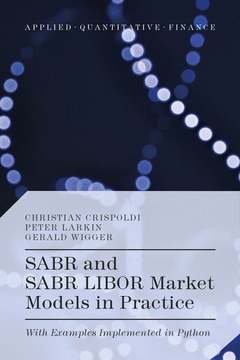Description
SABR and SABR LIBOR Market Models in Practice, 1st ed. 2015
With Examples Implemented in Python
Applied Quantitative Finance Series
Authors: Crispoldi Christian, Wigger Gérald, Larkin Peter
Language: English
Subjects for SABR and SABR LIBOR Market Models in Practice:
Keywords
derivatives; evolution; Monte Carlo Simulation; Simulation; volatility; banking
84.39 €
In Print (Delivery period: 15 days).
Add to cart
Publication date: 09-2015
216 p. · 15.5x23.5 cm · Hardback
216 p. · 15.5x23.5 cm · Hardback
Description
/li>Biography
/li>
Interest rate traders have been using the SABR model to price vanilla products for more than a decade. However this model suffers however from a severe limitation: its inability to value exotic products. A term structure model à la LIBOR Market Model (LMM) is often employed to value these more complex derivatives, however the LMM is unable to capture the volatility smile. A joint SABR LIBOR Market Model is the natural evolution towards a consistent pricing of vanilla and exotic products. Knowledge of these models is essential to all aspiring interest rate quants, traders and risk managers, as well an understanding of their failings and alternatives.
SABR and SABR Libor Market Models in Practice is an accessible guide to modern interest rate modelling. Rather than covering an array of models which are seldom used in practice, it focuses on the SABR model, the market standard for vanilla products, the LIBOR Market Model, the most commonly used model for exotic products and the extended SABR LIBOR Market Model. The book takes a hands-on approach, demonstrating simply how to implement and work with these models in a market setting. It bridges the gap between the understanding of the models from a conceptual and mathematical perspective and the actual implementation by supplementing the interest rate theory with modelling specific, practical code examples written in Python.
Christian Crispoldi is a Vice President at Nomura Holding America Inc., in New York where he is responsible for the valuation and pricing of interest rate derivatives. Previously he worked as a financial engineer in various banks across Europe. Christian holds a Masters degree in Mathematical Finance from the University of York, UK, and a bachelor degree in Computer Engineering from the University of Bologna, Italy.
Gérald Wigger is Head of Quantitative Analysis at Weisshorn Re. He previously worked in various roles such as Head of Pricing at Axa Winterthur, Head of Risk Modeling at Zürcher Kantonalbank and Interest Rate Derivatives Quant at Bank of America Merril Lynch. Gérald holds a PhD in Solid State Physics from ETH Zurich.
Peter Larkin is a Data Scientist working on building predictive models using big data in the (re) insurance industry. Previously he worked as a Quantitative Analyst in the financial services industry working on projects spanning the pricing of structured products, credit and market risk, and asset management. Peter has a background in Theoretical Physics and received his PhD from the University of York in 2008, previously having obtained his Masters at Cambridge University and BSc at Imperial College London. In 2012 he also completed a MSc in Mathematical Finance from the University of Oxford.
Gérald Wigger is Head of Quantitative Analysis at Weisshorn Re. He previously worked in various roles such as Head of Pricing at Axa Winterthur, Head of Risk Modeling at Zürcher Kantonalbank and Interest Rate Derivatives Quant at Bank of America Merril Lynch. Gérald holds a PhD in Solid State Physics from ETH Zurich.
Peter Larkin is a Data Scientist working on building predictive models using big data in the (re) insurance industry. Previously he worked as a Quantitative Analyst in the financial services industry working on projects spanning the pricing of structured products, credit and market risk, and asset management. Peter has a background in Theoretical Physics and received his PhD from the University of York in 2008, previously having obtained his Masters at Cambridge University and BSc at Imperial College London. In 2012 he also completed a MSc in Mathematical Finance from the University of Oxford.
© 2024 LAVOISIER S.A.S.




